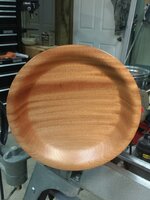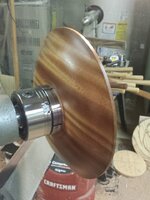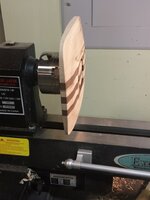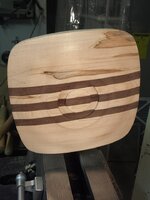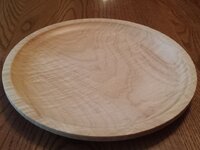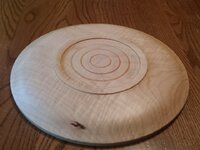pfbarney
Member
I started doing plates and platters recently and have really enjoyed the process. I've had a tendency to get too thin a few times, but even those have been fun up to the point I realize I've gone past the stopping point. I use a Woodworm screw for mounting most of the blanks on the lathe and turn a shallow recess on the back for re-mounting on the chuck to turn the front. I finish all of these with Mahoney's Walnut Oil so they're food safe.
The first is a 12" platter of sapele wood. The blank was about 2" thick, so I had plenty to work with. This is now my steak platter and I have eaten off of it a couple of times. It's holding up well.
Second is a WIP example of the small plates I made as Christmas presents. They are segmented of ambrosia maple and Peruvian walnut, about 8" across and obviously not round. I cut them on the band saw and sand to final shape before turning. On these, I used a 2 1/8" forstner bit to drill a shallow recess for initial mounting, then turned the back and created my recess for the re-mounting. Learned this method from a demo by Don Leydens at one of our guild meetings earlier this year. Video from a different guild at the link: http://youtu.be/ZKabIaz54Ek
Third is a plate I made for a secret Santa gift at work. It's bird's eye maple and about 9" in diameter. It was only about 1" thick when I started, so I used a plywood spacer for mounting with the screw and only had about three threads actually in the blank. As you can see, it held just fine and I was able to decorate the bottom a little bit this time.
I saw another thread where there was a bit of discussion about different ways of mounting blanks; using a screw chuck or a tenon or a recess. My experience with a screw chuck has been pretty good, though poplar is just too soft to work. The Nova Woodworm Screw I use recommends a 8 mm or 5/16th" hole and as long as the blank sits flush against the chuck, or the spacer, it works really well. Recess mounting has become my favorite method for working on the front side of bowls and plates. I have a difficult time doing the final turning when I have a tenon to deal with, but using a recess, I can finish the back of the piece completely and not have to worry about it anymore. These are just my thoughts and experiences and are by no means meant to be construed as a "correct for everyone" method.
Thanks for looking and Happy New Year! arty:
arty:
The first is a 12" platter of sapele wood. The blank was about 2" thick, so I had plenty to work with. This is now my steak platter and I have eaten off of it a couple of times. It's holding up well.
Second is a WIP example of the small plates I made as Christmas presents. They are segmented of ambrosia maple and Peruvian walnut, about 8" across and obviously not round. I cut them on the band saw and sand to final shape before turning. On these, I used a 2 1/8" forstner bit to drill a shallow recess for initial mounting, then turned the back and created my recess for the re-mounting. Learned this method from a demo by Don Leydens at one of our guild meetings earlier this year. Video from a different guild at the link: http://youtu.be/ZKabIaz54Ek
Third is a plate I made for a secret Santa gift at work. It's bird's eye maple and about 9" in diameter. It was only about 1" thick when I started, so I used a plywood spacer for mounting with the screw and only had about three threads actually in the blank. As you can see, it held just fine and I was able to decorate the bottom a little bit this time.
I saw another thread where there was a bit of discussion about different ways of mounting blanks; using a screw chuck or a tenon or a recess. My experience with a screw chuck has been pretty good, though poplar is just too soft to work. The Nova Woodworm Screw I use recommends a 8 mm or 5/16th" hole and as long as the blank sits flush against the chuck, or the spacer, it works really well. Recess mounting has become my favorite method for working on the front side of bowls and plates. I have a difficult time doing the final turning when I have a tenon to deal with, but using a recess, I can finish the back of the piece completely and not have to worry about it anymore. These are just my thoughts and experiences and are by no means meant to be construed as a "correct for everyone" method.
Thanks for looking and Happy New Year!

